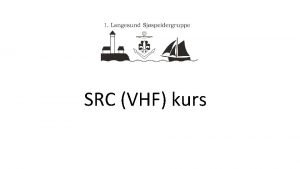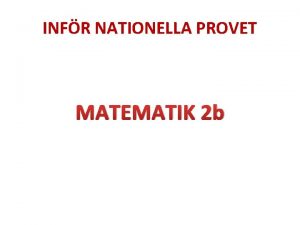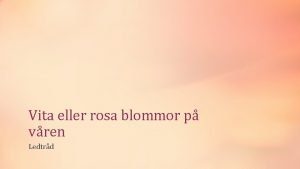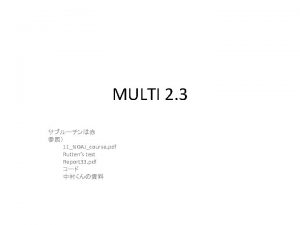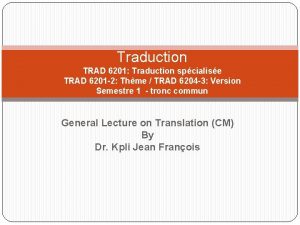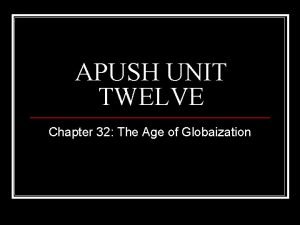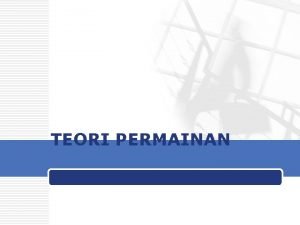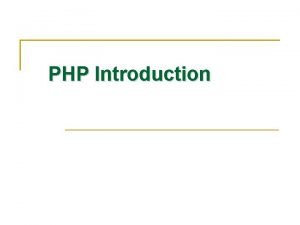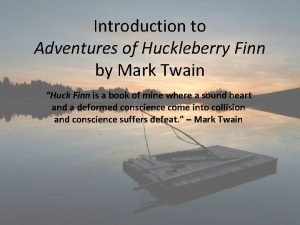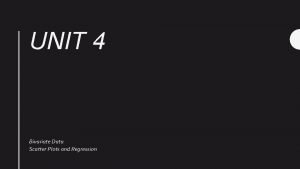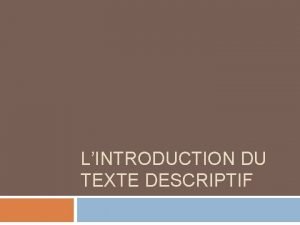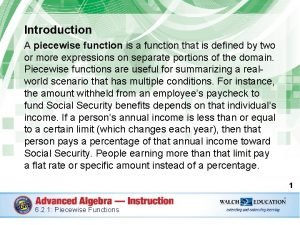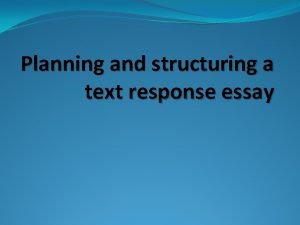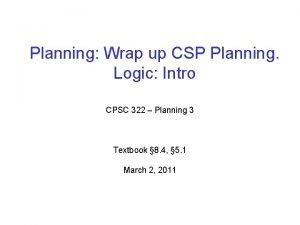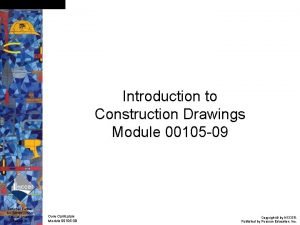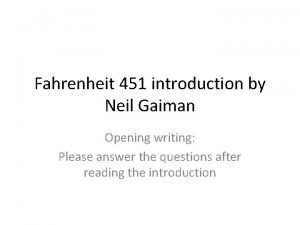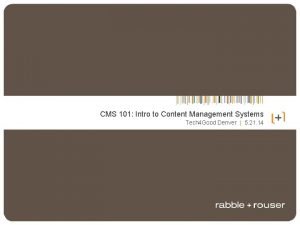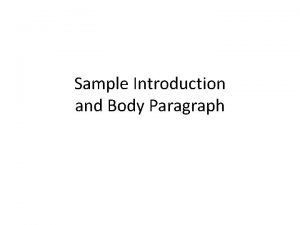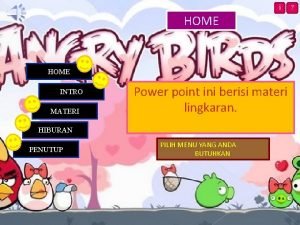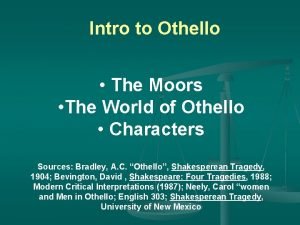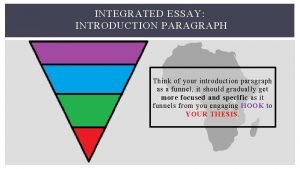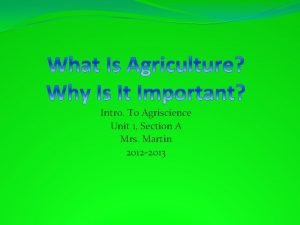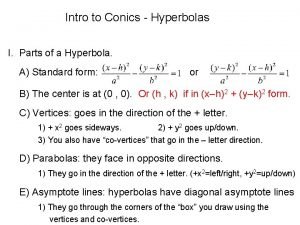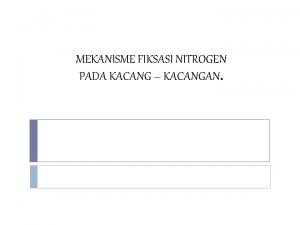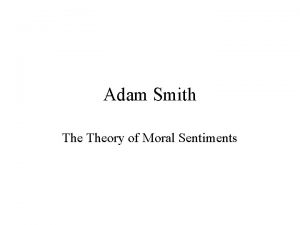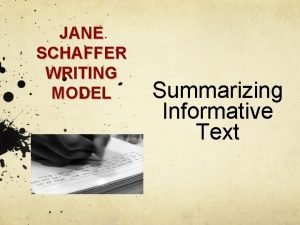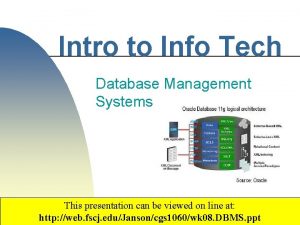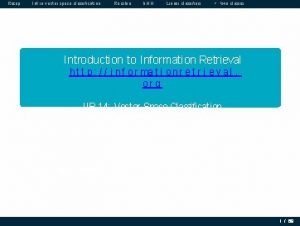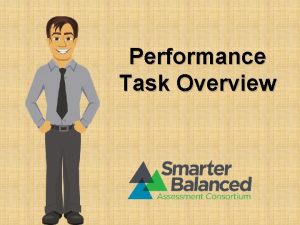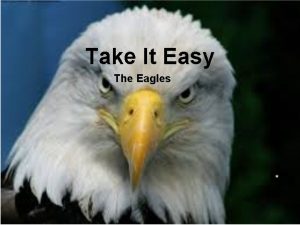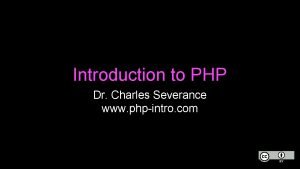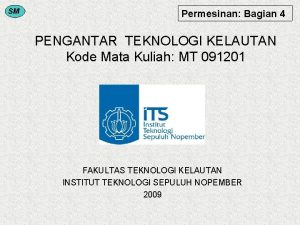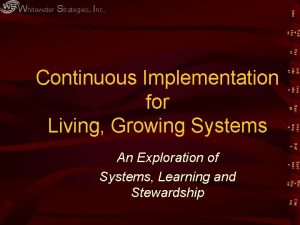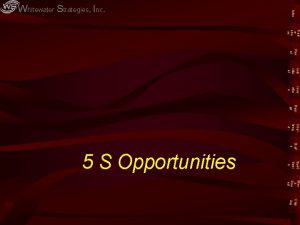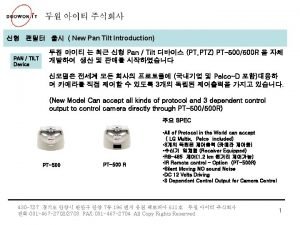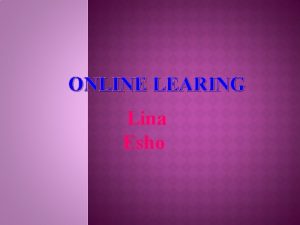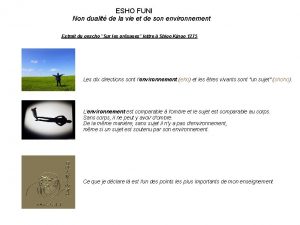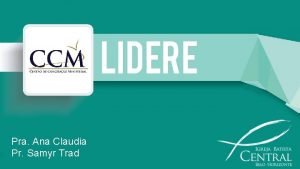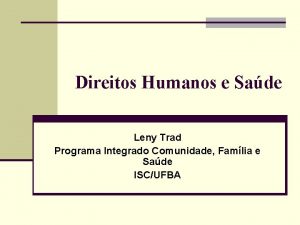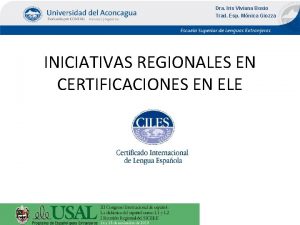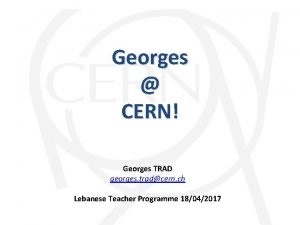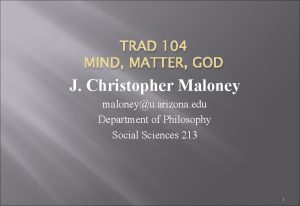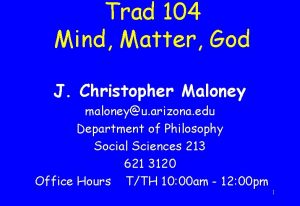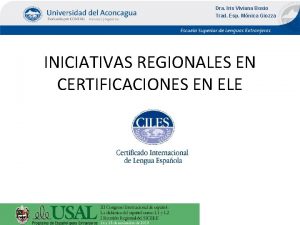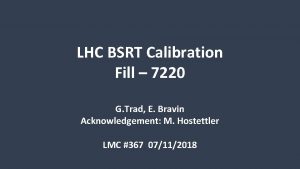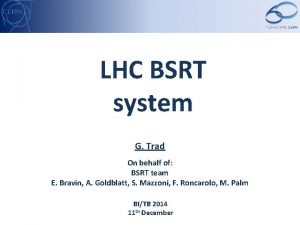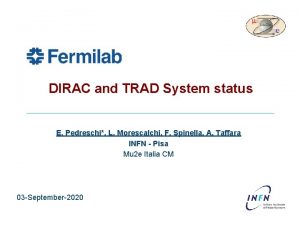Intro Whitewater Strategies Inc Trad esho w Pan
















































- Slides: 48

Intro Whitewater Strategies, Inc. Trad esho w Pan el CONFLICT LEADERSHIP Indi vidu al Inve ntio n Desi gn Chal leng e Draf t Synt hesi s An Experiential Workshop for Learning to Understand Lead Beyond Conflict Wor k Rou nd Clos ing 1

Intro Trad esho w Conflict’s Coming!!!!! Pan el Indi vidu al Inve ntio n Desi gn Chal leng e Draf t Synt hesi s Wor k Rou nd Clos ing 2

Intro Energy Collides!!! Trad esho w Pan el Indi vidu al Inve ntio n Desi gn Chal leng e Draf t Synt hesi s Wor k Rou nd Clos ing 3

Intro Trad esho w And Friends Emerge!!! Pan el Indi vidu al Inve ntio n Desi gn Chal leng e Draf t Synt hesi s Wor k Rou nd Clos ing 4

Intro Trad esho w NOT!!!!!!!!! Pan el Indi vidu al Inve ntio n Desi gn Chal leng e Draf t Synt hesi s Wor k Rou nd Clos ing 5

Intro Conflict Leadership Trad esho w Workshop Purposes Pan el • Our primary focus is to explore Conflict… Indi vidu al – What it is. – Why it is important. – How (as leaders) we can go beyond individual conflicts effectively. Inve ntio n Desi gn • Our process will include using real – personal examples. YOUR EXAMPLES!! Chal leng e – Please treat the things you will work on as confidential and personal. – Please be open enough to let us work on your real issues. Draf t • We believe that learning should be: Synt hesi s – Both Fun and Frustrating… – Both Energizing and Exasperating – Always an experience!!! Wor k Rou nd Clos ing 6

Intro Team Exercise #1 Getting Connected Trad esho w Indi vidu al Inve ntio n Desi gn Chal leng e Draf t Synt hesi s – Share who you are, where you work and why you are here. – Identify at least one unusual strength or interest for each member of your team. – Make a list of the top three to five things your group wants to get from this session. – Identify a “name” for your team which you feel represents your interests or goals and by which you can be identified for the rest of the session. Pan el • As a team – please discuss the following and be prepared to share your most important responses with the other teams. Wor k Rou nd Clos ing 7

Intro Group Exercise #1 Trad esho w Pan el Indi vidu al • The Facilitator will read Slinky Sam. • Individually complete the questionnaire at the bottom of the page indicating: Inve ntio n Desi gn – T = True Statement – F = False Statement – ? = Not sure if the Statement if True or False Chal leng e Draf t Synt hesi s • Be prepared to share the number you identified in each category. Wor k Rou nd Clos ing 8

Intro THE NATURE OF CONFLICT Trad esho w Pan el Indi vidu al Inve ntio n Desi gn –Conflict is neutral – neither positive nor negative, it just is. Chal leng e Draf t Synt hesi s Wor k Rou nd Clos ing 9

Intro Trad esho w Pan el Indi vidu al “Conflict is an interference pattern of energies. ” Inve ntio n Desi gn Chal leng e “Nature uses conflict as its primary motivator for change, creating beautiful beaches, canyons, mountains, and pearls. ” Draf t Wor k Rou nd Clos ing Thomas Crum 10 Synt hesi s “It’s not whether you have conflict in your life, it’s what you do with that conflict that makes a difference. ”

Intro THE NATURE OF CONFLICT Trad esho w Pan el – Conflict is neutral – neither positive nor negative, it just is. (Thomas Krum) Indi vidu al Inve ntio n –Conflict is not a contest!! Desi gn Chal leng e Draf t Synt hesi s Wor k Rou nd Clos ing 11

Intro Trad esho w Pan el “Winning and losing are goals for games, not for conflicts. ” Indi vidu al “Conflict can be seen as a gift of energy, in which neither side loses and a new dance is created. ” Desi gn Draf t Synt hesi s Wor k Rou nd Clos ing “Conflict begins within. As we unhitch the burden of belief systems and heighten our perceptions, we love more fully and freely. ” 12 Chal leng e “Resolving conflict is rarely about who is right. It is about acknowledgement and appreciation of difference. ” Inve ntio n “Learning, growing and cooperating are goals for resolving conflicts. ”

Intro Conflict is Inherent in Our Time Trad esho w Pan el • Change. . . . . Inve ntio n Desi gn Chal leng e Draf t Synt hesi s Wor k Rou nd Clos ing The Atlantic Journal -- June 16, 1883 Indi vidu al – The world is too big for us. Too much is going on, too many crimes, too much violence and excitement. Try as you will, you get behind in the race in spite of yourself. It is an incessant strain to keep pace, and still you lose ground. Science empties its discoveries on you so fast you stagger beneath them in hopeless bewilderment. The political world is changing so rapidly that you are out of breath trying to keep pace with who is in and who is out. Everything is high pressure. Human nature can’t endure much more!! 13

Intro Team Exercise #2 The Nature of Conflict Trad esho w Indi vidu al Inve ntio n Desi gn Chal leng e Draf t Synt hesi s – How do you first “feel” that there is a conflict? – What are the initiators of conflict? – Where does the passions, or lack of passion come from? – What do you like or value most about a “good” conflict? – What do you most need to learn about conflicts? Pan el • As a team – discuss and draw conclusions about the following: Wor k Rou nd Clos ing 14

Intro Team Exercise #3 Veginots in Conflict Trad esho w Indi vidu al Inve ntio n – The rest of the team will observe the process. – Dr. Smith and Dr. Harper will be given information on a conflict which they have to resolve. They should not read their information to the others in the group until the end. Pan el • In each Team – select one person to be Dr. Smith and one person to be Dr. Harper. Desi gn • Following the conflict period, discuss as a group: – – – Chal leng e What issues were actually in conflict? What issues did they spend most of their time on? How did the parties feel about their goals and needs? How openly was information shared between the parties? As observers – what suggestions did you have as Dr. Smith and Dr. Harper were talking? – What would you do if you could start the exercise again? Draf t Synt hesi s Wor k Rou nd Clos ing 15

Intro Individual Exercise #1 Desi gn Chal leng e Draf t o Compromising o Accommodating Inve ntio n Synt hesi s • Avoiding • Competing • Collaborating Indi vidu al – Which style requires the most energy from the participants? – What are the positive effects of each style? Pan el • Each of us responds differently to conflict based on a “preferred style. ” • To better understand your style – complete the Thomas -Kilman Instrument. • Answer the following in your workbook and we will discuss as a group. Trad esho w Thomas Killman Conflict Assessment Wor k Rou nd – What are the negative effects of each style? – What did you learn about yourself from this instrument? Clos ing 16

Intro Conflict Framework Trad esho w Thomas Killman Forcing domination Win/lose Problem-Solving Integration Win/Win Inve ntio n Degree of Involvement Collaborating Indi vidu al Competing Pan el High Compromising Desi gn Sharing Win a little/ Lose a little Chal leng e Avoiding Accommodating Draf t Uncooperative Lose/Lose Cooperative Lose/Win Synt hesi s Wor k Rou nd Low High Clos ing Degree of Cooperativeness 17

Pan el High Problem-Solving Integration Win/Win Inve ntio n Forcing domination Win/lose Moderate Energy Collaborating Indi vidu al Competing Compromising Moderate Energy Sharing Win a little/ Lose a little Chal leng e Low Energy Desi gn Draf t Avoiding Low Energy Cooperative Lose/Win Wor k Rou nd Low Uncooperative Lose/Lose Accomodating Synt hesi s Degree of Involvement Intro Personal Energy Needed Trad esho w Conflic t Energy High Clos ing Degree of Cooperativeness 18

Intro Avoiding Trad esho w Low Energ y Pan el • “Head in the Sand” – Lose/Lose • Answers come slowly since the parties avoid confronting the issues. • The personal costs may seem high. • Appropriate when: Indi vidu al Inve ntio n Desi gn Chal leng e – Time is needed to think… – Others should resolve the issues – Parties need time to cool off. Draf t Synt hesi s • Need to gain skills in effective confronting. Wor k Rou nd Clos ing 19

Intro Competing Trad esho w Moderat e Energy Pan el Indi vidu al Inve ntio n Desi gn Chal leng e Draf t Synt hesi s • “Winning is Everything” – Win/Lose • Willing to play hardball, use position power, the “fittest and toughest” wins. • Effective when quick decisions are needed and power relationships are accepted. • May miss valuing the reasons others disagree and risk alienating others. • Needs to learn “listening” and helping others be winners too. Wor k Rou nd Clos ing 20

Intro Accommodating Trad esho w Moderat e Energy Pan el Indi vidu al Inve ntio n Desi gn Chal leng e Draf t Synt hesi s Wor k Rou nd • “Have it Your Way” – Lose/Win • Values Relationship and cooperativeness over issues and results. • May get “run over” or feel “run over” and not know how to confront the reasons. • Effective where fast, reasonable group direction must be taken and they trust the issues are technical, not personal. • Must learn that it is “OK” to have conflict, express themselves openly, and put their ideas on the table. Clos ing 21

Intro Compromising Trad esho w Moderat e Energy Pan el Indi vidu al Inve ntio n Desi gn Chal leng e Draf t • “Let’s Bargain” – Win a little/Lose a little • Best where the issues are complex, both sides have equal power, and middle ground is the goal. • Differs from Collaboration in that the focus is on “concessions” (what will each side give up to get to the middle) rather than new options. • Need to learn to value the other parties needs and desires and seek new and creative win/win solutions. Synt hesi s Wor k Rou nd Clos ing 22

Intro Collaborating Trad esho w High Energy Pan el Indi vidu al Inve ntio n Desi gn Chal leng e Draf t Synt hesi s • “If you can dream it – You can do it” – Win/Win • Requires the faith that a mutually beneficial solution is possible – even though you don’t see it at the onset. • Requires creative thinking, valuing the other person strongly, and significant personal energy. • Use where the issues and the people are both important. • Must learn that not every decision requires the time investment of a collaborative decision. Wor k Rou nd Clos ing 23

Intro Conflict Leadership A Framework Trad esho w Pan el Indi vidu al Inve ntio n Desi gn Chal leng e Draf t Synt hesi s Wor k Rou nd • Balancing and Valuing the Energy • Seeking and Gaining Understanding • Creating and Adhering to Process • Building for Mutual Benefit (Win-Win) • Sharing Responsibility and Accountability Clos ing 24

Intro Balanced and Valuing The Energy Trad esho w Pan el Indi vidu al Inve ntio n Desi gn Chal leng e Draf t When a Freight Train is coming directly at you – you cannot stay balanced and stand in the middle of the tracks. To stay balanced, centered and steady – you have to move out of the direct path where you can observe and choose your action. Synt hesi s Wor k Rou nd Clos ing 25

Intro Balanced and Valuing The Energy Trad esho w Inve ntio n Desi gn Chal leng e • They often “move to the balcony” to see what is happening before evaluating the issues. Indi vidu al – Maintain personal balance – the approaching “Freight Train” will not “push” them to respond. Pan el • Leaders who effectively build “beyond” conflict are comfortable with themselves and with the nature of conflict. • When a conflict arises – they: Draf t – Value and appreciate the passion and energy that others are bringing. Synt hesi s • This passion can be directed to win-win solutions where “I don’t care” attitudes cannot. Wor k Rou nd Clos ing 26

Intro Habit of Proactivity Trad esho w Pan el • In “ 7 Habits of Highly Effective People” Steven Covey describes the Habit of Proactivity as – “Choosing your Response” Indi vidu al Inve ntio n Desi gn Chal leng e Under Pressure -- Many People Respond to Stimulus based on Habit. Draf t Stimulus Response Synt hesi s Wor k Rou nd Clos ing Proactive People Seize the opportunity to CHOOSE THEIR RESPONSE every time!! 27

Intro Seeking and Gaining Understanding Trad esho w Pan el • Another of the 7 Habits: Indi vidu al – “Seek First to Understand, then to be Understood. ” Inve ntio n • Effective Leaders make sure that “understanding” happens. Draf t Synt hesi s Wor k Rou nd – At this point they do not necessarily agree on the cause, remedy or action to be taken. That comes later. Chal leng e • The parties must come to a “common understanding” of the “elements” of the situation. Desi gn – The leader listens to understand the other side(s) of the situation. – The leaders helps others listen and understand all sides of the situation Clos ing 28

Intro Sources of Conflict Trad esho w Understanding Differences Pan el • Conflicts generally arise out of differences between Indi vidu al – FACTS – GOALS – METHODS -- VALUES. Inve ntio n Desi gn GOALS METHODS Chal leng e FACTS VALUES Draf t Synt hesi s Wor k Rou nd Judgmental Clos ing Rational 29

Intro Team Exercise #4 Sources of Conflict Trad esho w Indi vidu al Inve ntio n Desi gn Chal leng e Draf t Synt hesi s – Clarify where there is disagreement and where there is agreement in each of the areas outlined. – Summarize the top three or four areas of disagreement. – Summarize the top three or four areas of agreement. – Be prepared to share your results them with the other groups. Pan el • As a group – Identify a “real” conflict which you are facing or have faced in the past. • For this conflict: Wor k Rou nd Clos ing 30

Intro Differences in Facts Trad esho w FACTS Pan el • Stop talking at each other and repeating facts. • Clarify that there is a difference over the facts. Inve ntio n – “We see the same things differently. . . ”--“we have different facts. For example. . . ” Indi vidu al – “I think we’re saying the same things over and over. . . ” Desi gn • Establish criteria for acceptable facts. – “We need some guidelines about which facts to accept. ” Chal leng e • Decide whether the data you have is provable. Synt hesi s • Let go of the past. Draf t – “How can we prove the data in a way that’s acceptable to both of us? ” Wor k Rou nd – Allow all previous opinions and views to exist as true for the past – and move on. Decide now how to prevent future confusion over facts. Clos ing • Develop methods for resolving differences over facts (now and in the future). 31

Pan el • Clarify that there appears to be a difference in goals. Intro Differences in Goals Trad esho w GOALS – “We have different goals. . . ” – “Your goal appears to be. . . ” Draf t Synt hesi s Wor k Rou nd Clos ing – “Since we can’t agree on a common goal, and each of us feels 32 strongly about our own – let’s choose someone to decide between them. ” Chal leng e • Identify the difference between the goals. • Determine what will happen to the other’s goal if yours is met. • Determine what will happen to your goal if the other’s is met. • If a common goal is not possible, agree on someone to decide which goal has priority. Desi gn • Learn and state the other’s specific goals and be open for correction and clarification. Inve ntio n – “My goals are. . . ” Indi vidu al • State your specific goals.

Differences in Methods Intro METHODS Trad esho w Synt hesi s Wor k Rou nd Clos ing • Together establish criteria for judging the best method. Apply these criteria to your proposed methods. • Try to establish alternative methods acceptable to both of you. • Decide who will choose methods if you can’t resolve 33 the difference yourselves. Draf t – “The real difference is. . . ” Chal leng e • Identify differences between the methods Desi gn – Learn and state clearly the other’s method and be open to correction and clarification. Inve ntio n • State clearly your method. Indi vidu al – “We both want the same outcome; we have different ways of going about it. ” Pan el • Clarify that the difference is over how and not what to do.

Differences in Values Intro VALUES Trad esho w Desi gn Chal leng e Draf t Synt hesi s Wor k Rou nd Clos ing 34 Inve ntio n • Hear and repeat the other’s value and be open to correction and clarification. • Acknowledge both values as legitimate. Avoid assigning right and wrong. • State clearly the difference in values as it applies to this situation. • Determine how both values can be preserved in this situation. • Establish criteria for success. How will it look when our values are met in this situation? Indi vidu al – State clearly that underlying value you consider important. Pan el • Clarify that you’re talking about differing values that are important to each of you.

y? Annoying, Frustrating and Enlightening Trad esho w Wh The 5 Whys? ? ? Intro Wh y? Why? Pan el Indi vidu al • The “real reason” is rarely found with a single question. Draf t Synt hesi s Wor k Rou nd • Then by following-up the initial discussion with the Five Probing Whys…… Chal leng e – Why you are here -- Why you are doing what you are doing – or Why do you want what you want. Desi gn • Whenever you want to build common understanding, purpose, and meaning, ask the “Five Whys. ” • Begin by exploring: Inve ntio n – Often we have to probe deeply to understanding the underlying feelings and discover the root causes. Clos ing 35

Wh y? Trad esho w Why? Intro W hy? y? Wh ? Why 5 Probing Whys Pan el Initial Response – It is important because… Inve ntio n Why is THAT important to you? ? Indi vidu al Why is that important to you? ? Response – It is important because… Chal leng e Why is THAT important to you? ? Desi gn Response – It is important because… Draf t 36 Clos ing Deepest Response – It is important because… Wor k Rou nd Why is THAT important to you? ? Response – It is important because… Synt hesi s Why is THAT important to you? ?

Intro Creating and Adhering to Process Trad esho w Pan el • “Even the “Hokey Pokey” had a process. ” (You put your right hand in, …. ) • Understanding the Conflict is step one of the Process. • To go from “understanding” to “resolution” or a new plan, we must be able to: Indi vidu al Inve ntio n Desi gn Chal leng e Draf t – Build a step-by-step process to get to resolution. – Commit to follow the process. Synt hesi s Wor k Rou nd Clos ing 37

Intro Team Exercise #5 Trad esho w Creating and Adhering to Process Pan el • With your team: Inve ntio n Desi gn Chal leng e Draf t Synt hesi s Wor k Rou nd Clos ing 38 Indi vidu al – Select a second Conflict and clarify the issues involved. – Follow the “sample” process outlined in the workbook and create a specific plan for resolving conflict. – Identify problems in the process which you would change or adjust in order to make it better. – Be prepared to share your learning with the other groups.

Intro Thoughts on Process Trad esho w Pan el • Building a process often starts with asking the right questions. Below are several questions which may help you get to a great process. Indi vidu al Inve ntio n Desi gn Chal leng e Draf t Synt hesi s Wor k Rou nd – Who are all the individuals who need to be involved in resolving this issue? – How can we make sure that all parties are heard? – How will we collect – assemble the data? – When will we meet? – When must we have resolution? – Are we willing to commit to resolve it together? – What other resources or tools do we need to be effective? Clos ing 39

Intro A Sample Process Trad esho w Take the appropriate immediate response Pan el • – Interrupt the conflict and suspend discussion --Move to a neutral site Set ground rules & get agreement Clarify what is in conflict Desi gn Separate the people from the problem Separate fact from opinion/perceptions Decide what is trivial and what is important Identify the issues (incompatible options, differences, understandings, opinions, or beliefs related to: ) Inve ntio n – – Indi vidu al • • • Goals, Methods, Ideas, Facts, Values, Needs, Roles/Responsibilities Chal leng e – Identify Resources Needed • People involved, with information/knowledge • Set a time and place for resolving the conflict Clos ing Get commitment to finding a solution together Brainstorm options Evaluate the options (possible consequences, etc. ) Select an option (seek win/win) Clarify agreements, set action items & responsibility and get commitments 40 Follow up to insure accountability Wor k Rou nd • • • Synt hesi s – Re-clarify expectations, ground rules & goals Draf t – Complete the discovery process

Intro Building for Mutual Benefit (Win/Win) Trad esho w Indi vidu al Inve ntio n Desi gn Chal leng e Draf t Synt hesi s – An “Abundance Mentality” – Creative Thinking – Exploring Possibilities rather than Defending Positions Pan el • “If you can Dream it – You can do it” (Walt Disney) • Conflict Leadership requires that we transcend our preferred or “natural” style and work toward a collaborative, win-win option which meets the greater portion of all the participants needs. • Finding Win/Win Solutions Requires: Wor k Rou nd Clos ing 41

Intro Group Exercise #2 Trad esho w Brainstorming Win/Win Solutions Pan el • A “real situation” will be selected from the teams. Please remember these are personal, real Indi vidu al and confidential situations. Chal leng e Draf t The ideas that “everyone could have figured out. ” The ideas that were “really silly. ” The ideas that “could not possibly work. ” The ideas that require a scientific breakthrough. The ideas that were just plain stupid. Sooooo – let’s list all of the above!!! Desi gn Synt hesi s Wor k Rou nd Clos ing – – – Inve ntio n • As a group – we will attempt to brainstorm solutions to this situation. The genuinely “new and creative” “win/win” solutions seldom come until after: 42

Intro Sharing Responsibility and Accountability Trad esho w Inve ntio n Desi gn Chal leng e Draf t Synt hesi s Wor k Rou nd Clear Actionable Mutual (involve both or all parties) Accountable (reviewed, improved and recommitted to regularly. ) Indi vidu al – – Pan el • “Establishing a Budget is a great first step to financial responsibility. Following, Reviewing, and accounting to that budget are required if you expect to retire before you are 98 ½. ” • Resolution is not an end point – it’s the beginning of a new agreement. That agreement must be: Clos ing 43

Intro Team Exercise #6 Leading Beyond Conflict Trad esho w Pan el • As a Team: Inve ntio n Balance and Value the energy Seek and Gain Understanding Create and Adhere to Process Build for Mutual Benefit (Win-Win) Share Responsibility and Accountability Desi gn Chal leng e Draf t • • • Indi vidu al – Select another specific conflict which is of immediate interest to a member of the team. – Talk through the entire process and build a specific strategy that will help that team member to: Synt hesi s – Identify your key learnings from this exercise and be prepared to share your thoughts with the group. Wor k Rou nd Clos ing 44

Intro Pan el • Need: Draf t Synt hesi s Wor k Rou nd Clos ing 45 Fred Price --Williams Communications Chal leng e • Maintaining high standards and • Maintaining relationships, including people & working together Desi gn Expect more of each other Build consistency at a higher standard Put ourselves in order before we fix everyone else Learn to balance a basic conflict between: Inve ntio n • Need to: Indi vidu al – Support – from above and from each other – Courage – to do what’s “Right” – Understanding – of people as well as issues – – Trad esho w Things Leaders Need & Need to Do…

Intro Reading Review Pan el Indi vidu al Inve ntio n Desi gn Chal leng e Draf t Synt hesi s • What are the key advantages of a “team” in which the members do not always “get along? ” • What are the key disadvantages of a team which “gets along” all the time? • In what way can being a “team player” be used to stifle creative and beneficial conflict? • Why do we avoid assembling a team of “fighters” rather than “team players? ” • What is the most important point of this article for you? … for your organization? Trad esho w Home “How Management Teams Can Have a Good Fight” Work Wor k Rou nd Clos ing 46

Intro Reading Review “Don’t avoid Conflicts – Manage Them” Trad esho w Home Work Pan el Indi vidu al Inve ntio n Desi gn Chal leng e Draf t • Which key concept do you personally have to work on most and why? • Which key concept should you work on most in your organization and why? • How can we help each other, as leaders, resolve rather than avoid conflicts? Synt hesi s Wor k Rou nd Clos ing 47

Intro The Challenge Trad esho w Pan el Indi vidu al Inve ntio n Desi gn Chal leng e Draf t Synt hesi s Wor k Rou nd • “In this new world, you and I make it up as we go along, not because we lack expertise or planning skills, but because that is the nature of reality. Reality changes shape and meaning because of our activity. And it is constantly new. We are required to be there, as active participants. It can’t happen without us and nobody can do it for us. ” —Margaret Wheatley Clos ing 48
 Pan pan melding
Pan pan melding Oldi messages
Oldi messages Matematik 2b nationella prov
Matematik 2b nationella prov Körsbärsträd med rosa blommor
Körsbärsträd med rosa blommor Trad
Trad Vw771
Vw771 Common dutch first names
Common dutch first names Trad theory
Trad theory étoffement traduction
étoffement traduction Globalization apush
Globalization apush Willimantic whitewater park
Willimantic whitewater park Abc unified school district
Abc unified school district William jefferson clinton apush
William jefferson clinton apush Whitewater test star equation
Whitewater test star equation Contoh kasus strategi murni
Contoh kasus strategi murni Control structures in php
Control structures in php Huckleberry finn intro
Huckleberry finn intro Unit 4 worksheet #1 intro to correlation
Unit 4 worksheet #1 intro to correlation Texte argumentatif exemple
Texte argumentatif exemple Piecewise function introduction
Piecewise function introduction Text response essay structure
Text response essay structure Logic intro
Logic intro Module 00105 introduction to construction drawings
Module 00105 introduction to construction drawings Bd max intro
Bd max intro Neil gaiman intro to fahrenheit 451
Neil gaiman intro to fahrenheit 451 Nature of hrm
Nature of hrm Intro to cms
Intro to cms Intro body conclusion example
Intro body conclusion example Example of a introduction paragraph
Example of a introduction paragraph Contoh intro power point
Contoh intro power point Who are the moors in othello
Who are the moors in othello Integrated paragraph examples
Integrated paragraph examples Agriscience definition
Agriscience definition Forensic science chapter 1
Forensic science chapter 1 Hyperbola graph
Hyperbola graph Intro fiksasi adalah
Intro fiksasi adalah Define stagecraft
Define stagecraft Eva och adam intro
Eva och adam intro Jane schaffer body paragraph
Jane schaffer body paragraph Intro
Intro What is corrections in criminal justice
What is corrections in criminal justice Introduction to poetry סיכום
Introduction to poetry סיכום Intro
Intro Intro for performance task
Intro for performance task Eagles intro
Eagles intro Var_dump in php
Var_dump in php Lynda intro
Lynda intro Intro to human resource management
Intro to human resource management Intro to code
Intro to code
